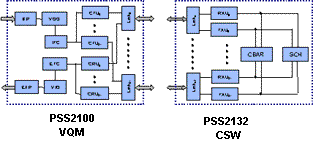CLOUD
Emerging Companies Series: PetaSwitch Solutions, Inc.
By Steve Fisher, Editor In Chief -- This second installment in the Supercomputing Online Emerging Companies Series focuses on PetaSwitch Solutions, a small firm focused on building new multi-generation switch fabrics. The young company offers a switch fabric that scales up to 256 ports and up to a whopping 10Tbps of switching capacity. Incorporated in November of 2000, Santa Clara, CA-based PetaSwitch Solutions is a small firm focused on building new multi-generation switch fabrics that support the ever increasing demands of high speed SANs, MANs (Metropolitan Area Networks), and WANs. The company received its first round of funding, four million dollars, in June of last year from Wasserstein Ventures and Draper Fisher Jurvetson. The company offers a switch fabric that scales up to 256 ports and up to 10Tbps of switching capacity. The chipset can accommodate linecards with an array of port speeds, including Gigabit Ethernet, OC-48, 10 Gigabit Ethernet, OC-192, OC-768 and OC-3072. The firm sees its architecture as ideal for applications in Storage Area Networks (SAN), Metropolitan Area Networks (MAN), Wide Area Networks (WAN) and edge switching and routing applications between the MAN and the WAN. PetaSwitch’s flagship product is the Pisces chipset, which consists of the PSS2100 Virtual Queue Manager (VQM) and the PSS2132 Concurrent Switch (CSW). The VQM offers: support for CSIX-L1 CFRAME packet format, CSIX/SPI-4 interface; dynamic virtual queuing for 8 priorities/destination; efficient spatial multicasting, flow control and deficit accounting; 32 - 3.125 Gbps FDX links to Concurrent Switch; traffic rerouting to avoid faulty links; and a single VQM supports: 1 OC-768, 4 OC-192, 4 OC-48 pipes. The technical break-down of the CSW is as follows: multiple CSW’s aggregate bandwidth goes up to 10 Tbps (the number determines the maximum system bandwidth); 32 - 3.125 link version of the CSW enables 5 Tbps and the 64 - 3.125 version enables 10Tbs; supports spatial multicasting and flow control; a scheduler which schedules based on virtual queue priority; a memory-less crosspoint.
There are several ways that the PetaSwitch chipset differs from the offerings of the company’s competitors. First, it is the only offering that adds an acknowledgement to their request grant protocol. This saves network processor/traffic manager memory space and cycles. It also allows the VQM to know quickly if traffic was not received so it can request a re-transmit without the lengthy delay involved when the network Processor (NP) orders it. Secondly, their product is the only one to use in-band intelligent flow control. This slows ingress traffic in steps as queues fill and slows ingress traffic when egress port is temporarily blocked. Traffic continues to flow unless a permanent port blockage occurs. A third differentiator is a spatial multicasting scheme. The chips can be replicated to obtain higher numbers of ports and/or higher bandwidth of the ports. Port speeds from OC-48 (2.5 Gbps) to OC-3072 (160 Gbps) can be accommodated to produce switches with over 5 Tbps bandwidth. Finally, is what the company refers to as, “built-in” fault tolerance. All CSW’s have a scheduler but only a selected few are the Master’s in the system. If one of the Master CSW schedulers fail, control is automatically transferred to a slave and it becomes the Master. If a link between VQM and CSW becomes inoperable for some reason, other links will share the traffic. “We feel that we are the only company who can preserve their [customers] investment. Essentially the idea here is to reduce the risk of obsolescence. The whole idea is to develop a switch fabric which can meet multiple generations of the demanding high speed storage market and metropolitan market,” said Dipak Shah, CEO PetaSwitch Solutions. Here are the value propositions for PetaSwitch’s chipset offering as I see them. It is suitable for a number of different applications, it offers built-in fault tolerance, it is highly available to all kinds of traffic, it’s capable of nearly fantastic scalability, and full redundancy is easily implemented. "We are pleased that we are gaining traction with companies producing equipment for SAN, MAN, WAN and Edge applications. The common need is scalability in both port count and port speed using the same chipset,” said Fred Kamp, PetaSwitch VP of Marketing. “System vendors are telling us that our multi-generation switch fabric is the only solution that will meet their current and future equipment requirements. Our solution enables them to preserve their investment by reducing the risk of obsolescence." So, if PetaSwitch can ship its product on time, which it is scheduled to do, it seems like it will be well positioned with one of the few Terabit switch fabrics available in 2002.
 |
| PetaSwitch Virtual Queue Manager & Concurrent Switch |
Like
Like
Happy
Love
Angry
Wow
Sad
Comments (0)

 How to resolve AdBlock issue?
How to resolve AdBlock issue?